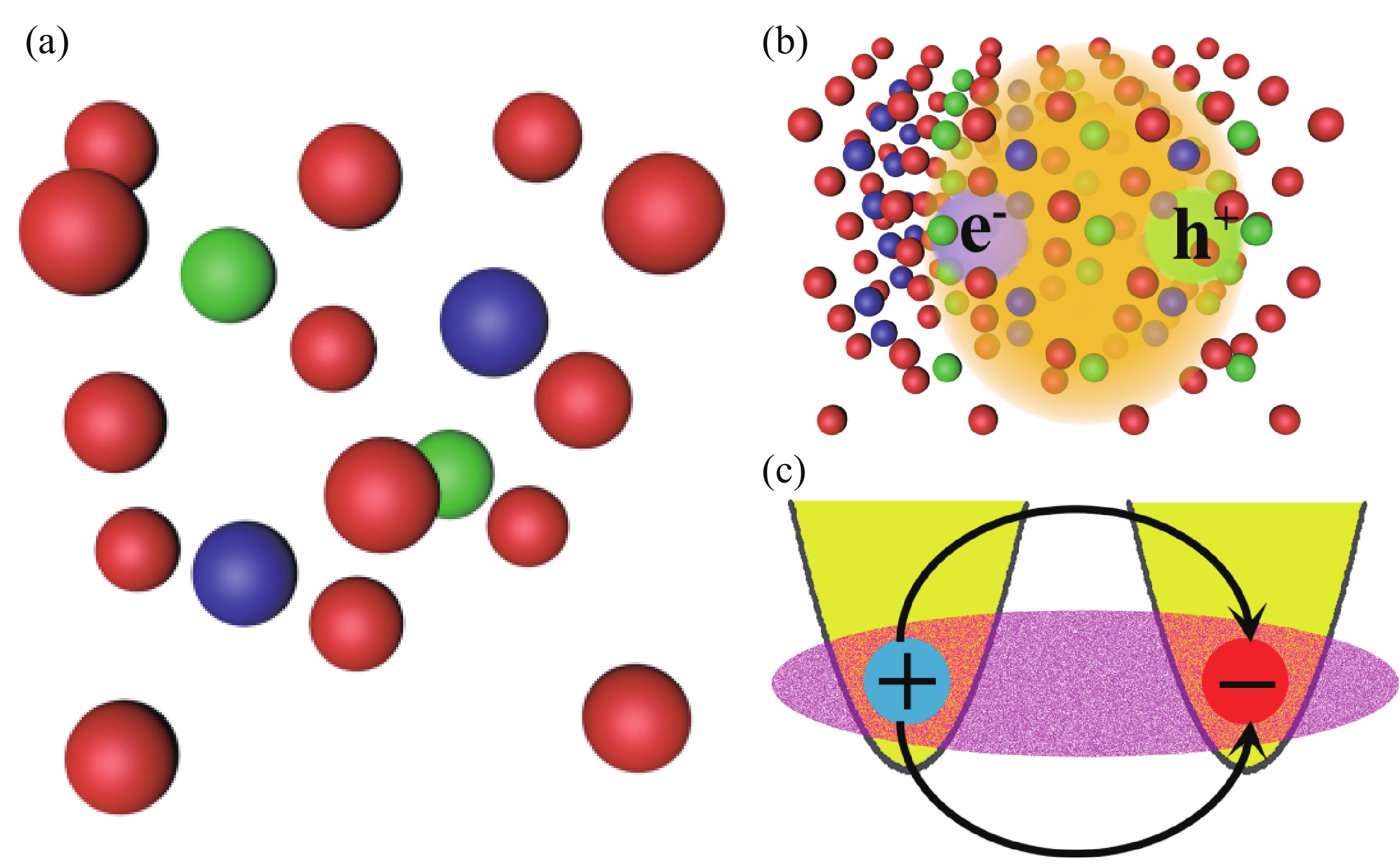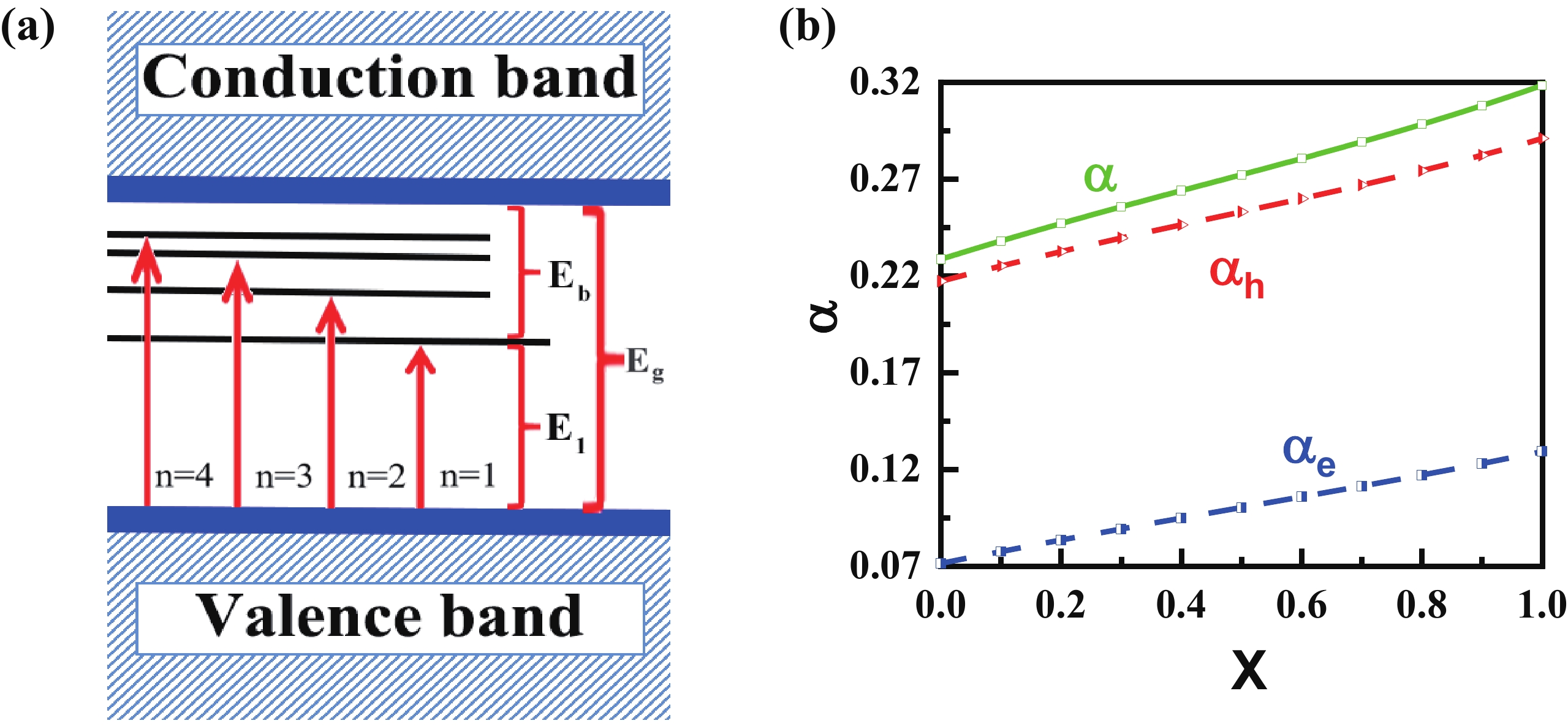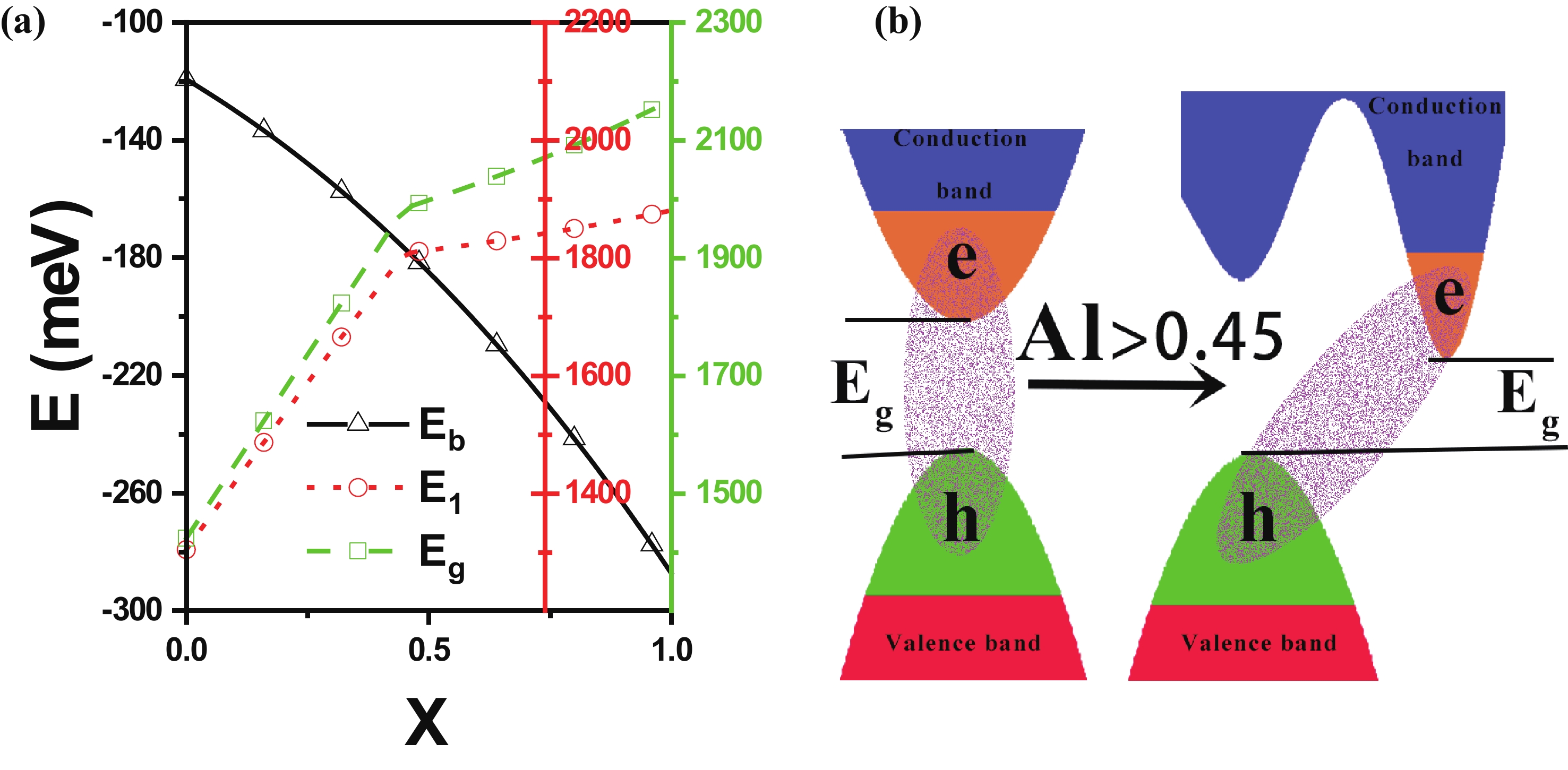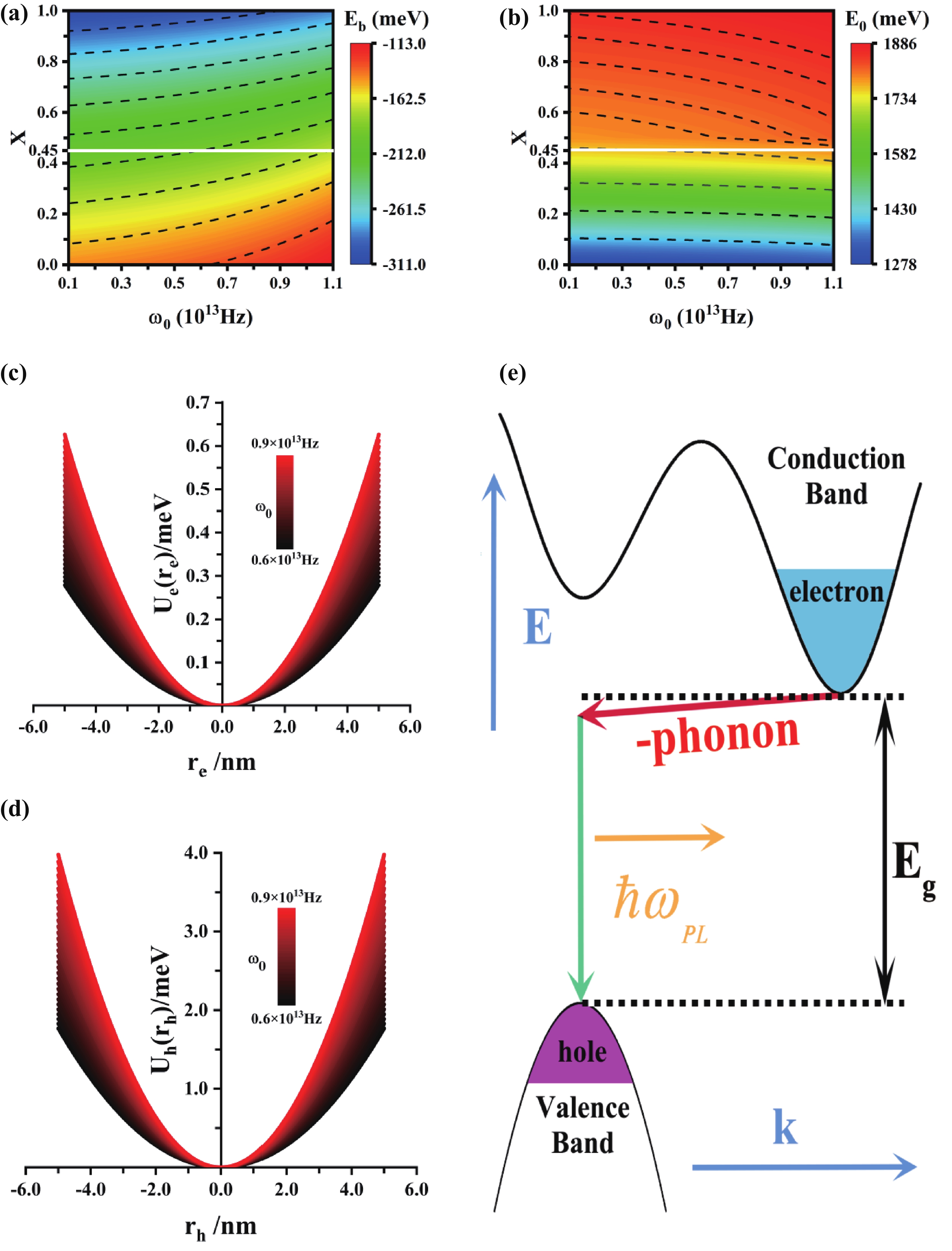| Citation: |
Yong Sun, Wei Zhang, Shuang Han, Ran An, Xin-Sheng Tang, Xin-Lei Yu, Xiu-Juan Miao, Xin-Jun Ma, Xianglian, Pei-Fang Li, Cui-Lan Zhao, Zhao-Hua Ding, Jing-Lin Xiao. Behavior of exciton in direct−indirect band gap AlxGa1−xAs crystal lattice quantum wells[J]. Journal of Semiconductors, 2024, 45(3): 032701. doi: 10.1088/1674-4926/45/3/032701
****
Y Sun, W Zhang, S Han, R An, X S Tang, X L Yu, X J Miao, X J Ma, Xianglian, P F Li, C L Zhao, Z H Ding, J L Xiao. Behavior of exciton in direct−indirect band gap AlxGa1−xAs crystal lattice quantum wells[J]. J. Semicond, 2024, 45(3): 032701. doi: 10.1088/1674-4926/45/3/032701
|
Behavior of exciton in direct−indirect band gap AlxGa1−xAs crystal lattice quantum wells
DOI: 10.1088/1674-4926/45/3/032701
More Information
-
Abstract
Excitons have significant impacts on the properties of semiconductors. They exhibit significantly different properties when a direct semiconductor turns in to an indirect one by doping. Huybrecht variational method is also found to influence the study of exciton ground state energy and ground state binding energy in AlxGa1−xAs semiconductor spherical quantum dots. The AlxGa1−xAs is considered to be a direct semiconductor at Al concentration below 0.45, and an indirect one at the concentration above 0.45. With regards to the former, the ground state binding energy increases and decreases with Al concentration and eigenfrequency, respectively; however, while the ground state energy increases with Al concentration, it is marginally influenced by eigenfrequency. On the other hand, considering the latter, while the ground state binding energy increases with Al concentration, it decreases with eigenfrequency; nevertheless, the ground state energy increases both with Al concentration and eigenfrequency. Hence, for the better practical performance of the semiconductors, the properties of the excitons are suggested to vary by adjusting Al concentration and eigenfrequency -
References
[1] Dong H L, Jia T T, Liang J, et al. Improved carrier transport and photoelectric properties of InGaN/GaN multiple quantum wells with wider well and narrower barrier. Opt Laser Technol, 2020, 129, 106309 doi: 10.1016/j.optlastec.2020.106309[2] Liu N, Hu G W, Dan M J, et al. Piezo-phototronic effect on quantum well terahertz photodetector for continuously modulating wavelength. Nano Energy, 2019, 65, 104091 doi: 10.1016/j.nanoen.2019.104091[3] Xia L P, Huang J N, Zhou E, et al. A photoelectric synapse based on optimized perovskite CH3NH3PbBr3 quantum dot film detectors. Appl Phys Lett, 2022, 120, 261112 doi: 10.1063/5.0096692[4] Liu Y, Du L Y, Gu K K, et al. Effect of Tm dopant on luminescence, photoelectric properties and electronic structure of In2S3 quantum dots. J Lumin, 2020, 217, 116775 doi: 10.1016/j.jlumin.2019.116775[5] Wang X, Feng Y Q, Dong P P, et al. A mini review on carbon quantum dots: Preparation, properties, and electrocatalytic application. Front Chem, 2019, 7, 671 doi: 10.3389/fchem.2019.00671[6] Liu F, Ding C, Zhang Y H, et al. GeI2 additive for high optoelectronic quality CsPbI3 quantum dots and their application in photovoltaic devices. Chem Mater, 2019, 31, 798 doi: 10.1021/acs.chemmater.8b03871[7] Gong X, Guan L, Li Q W, et al. Black phosphorus quantum dots in inorganic perovskite thin films for efficient photovoltaic application. Sci Adv, 2020, 6, eaay5661 doi: 10.1126/sciadv.aay5661[8] Lorenz S, Erickson C S, Riesner M, et al. Directed exciton magnetic polaron formation in a single colloidal Mn2+: CdSe/CdS quantum dot. Nano Lett, 2020, 20, 1896 doi: 10.1021/acs.nanolett.9b05136[9] Ma X J, Zhang W, Han S A, et al. The level-splitting effects of spin-orbit interaction on strong-coupling polaron in quantum dots with alkali halide. Phys E, 2022, 144, 115387 doi: 10.1016/j.physe.2022.115387[10] Deng Y Z, Lin X, Fang W, et al. Deciphering exciton-generation processes in quantum-dot electroluminescence. Nat Commun, 2020, 11, 2309 doi: 10.1038/s41467-020-15944-z[11] Fobasso M F C, Fotue A J, Kenfack S C, et al. Stability and coherence of strong-coupling magneto-bipolaron in asymmetric quantum dot under laser field effect. Phys Lett A, 2018, 382, 3490 doi: 10.1016/j.physleta.2018.10.009[12] Konishi K, Naka N. Phonon-assisted excitonic absorption in diamond. Phys Rev B, 2021, 104, 125204 doi: 10.1103/PhysRevB.104.125204[13] Geiregat P, Rodá C, Tanghe I, et al. Localization-limited exciton oscillator strength in colloidal CdSe nanoplatelets revealed by the optically induced stark effect. Light, 2021, 10, 112 doi: 10.1038/s41377-021-00548-z[14] Qin M B, Duan J Y, Xiao S Y, et al. Manipulating strong coupling between exciton and quasibound states in the continuum resonance. Phys Rev B, 2022, 105, 195425 doi: 10.1103/PhysRevB.105.195425[15] Gao X, Shen Y Q, Liu J J, et al. Boosting the photon absorption, exciton dissociation, and photocatalytic hydrogen- and oxygen-evolution reactions by built-in electric fields in Janus platinum dichalcogenides. J Mater Chem C, 2021, 9, 15026 doi: 10.1039/D1TC03628A[16] Morozov S, Wolff C, Mortensen N A. Room-temperature low-voltage control of excitonic emission in transition metal dichalcogenide monolayers. Adv Opt Mater, 2021, 9, 2101305 doi: 10.1002/adom.202101305[17] Alijabbari M, Mehramiz A, Mafi A. The energy states of an electron in a spheroidal quantum dot with finite barrier. Superlattices Microstruct, 2019, 133, 106180 doi: 10.1016/j.spmi.2019.106180[18] Hbibi M, Mommadi O, Chouef S, et al. Finite confinement potentials, core and shell size effects on excitonic and electron-atom properties in cylindrical core/shell/shell quantum dots. Sci Rep, 2022, 12, 14854 doi: 10.1038/s41598-022-19118-3[19] Ji B T, Rabani E, Efros A L, et al. Dielectric confinement and excitonic effects in two-dimensional nanoplatelets. ACS Nano, 2020, 14, 8257 doi: 10.1021/acsnano.0c01950[20] Klahold W M, Choyke W J, Devaty R P. Band structure properties, phonons, and exciton fine structure in 4H-SiC measured by wavelength-modulated absorption and low-temperature photoluminescence. Phys Rev B, 2020, 102, 205203 doi: 10.1103/PhysRevB.102.205203[21] Qiu D Y, Cohen G, Novichkova D, et al. Signatures of dimensionality and symmetry in exciton band structure: Consequences for exciton dynamics and transport. Nano Lett, 2021, 21, 7644 doi: 10.1021/acs.nanolett.1c02352[22] Baranowski M, Plochocka P, Su R, et al. Exciton binding energy and effective mass of CsPbCl3: A magneto-optical study: Publisher’s note. Photon Res, 2022, 10, 2447 doi: 10.1364/PRJ.475369[23] Liu Y, Wang J, Zhu N, et al. Investigation on binding energy and reduced effective mass of exciton in organic–inorganic hybrid lead perovskite films by a pure optical method. Opt Lett, 2019, 44, 3474 doi: 10.1364/OL.44.003474[24] Jahanshir A. Relativistic modification of the exciton’s mass in monolayer TMDCs materials. Journal of Advanced Materials and Processing, 2020, 8(4), 45[25] Chafai A, Essaoudi I, Ainane A, et al. Nonlinear optical characteristics of an exciton in a GaSb-capped InSb heterodot: Role of size control. Eur Phys J Plus, 2020, 135, 203 doi: 10.1140/epjp/s13360-019-00003-4[26] Chen X H, Lu H P, Wang K, et al. Tuning spin-polarized lifetime in two-dimensional metal–halide perovskite through exciton binding energy. J Am Chem Soc, 2021, 143, 19438 doi: 10.1021/jacs.1c08514[27] Zheng R S, Matsuura M. Exciton binding energies in polar quantum wells with finite potential barriers. Phys Rev B, 1998, 58, 10769 doi: 10.1103/PhysRevB.58.10769[28] Filinov A V, Riva C, Peeters F M, et al. Influence of well-width fluctuations on the binding energy of excitons, charged excitons, and biexcitons in GaAs-based quantum wells. Phys Rev B, 2004, 70, 035323 doi: 10.1103/PhysRevB.70.035323[29] Baranowski M, Plochocka P. Excitons in metal-halide perovskites. Adv Energy Mater, 2020, 10, 1903659 doi: 10.1002/aenm.201903659[30] Adamska L, Umari P. Bethe-Salpeter equation approach with electron-phonon coupling for exciton binding energies. Phys Rev B, 2021, 103, 075201 doi: 10.1103/PhysRevB.103.075201[31] Huang T A, Zacharias M, Lewis D K, et al. Exciton–phonon interactions in monolayer germanium selenide from first principles. J Phys Chem Lett, 2021, 12, 3802 doi: 10.1021/acs.jpclett.1c00264[32] Shree S, Semina M, Robert C, et al. Observation of exciton-phonon coupling in MoSe2 monolayers. Phys Rev B, 2018, 98, 035302[33] Lee T D, Low F E, Pines D. The motion of slow electrons in a polar crystal. Phys Rev, 1953, 90, 297 doi: 10.1103/PhysRev.90.297[34] Huybrechts W J. Internal excited state of the optical polaron. J Phys C, 1977, 10, 3761 doi: 10.1088/0022-3719/10/19/012[35] Hai G Q, Peeters F M, Devreese J T. Polaron energy and effective mass in a quantum well. Phys Rev B, 1990, 42, 11063 doi: 10.1103/PhysRevB.42.11063[36] Chuu D S, Lou Y C. Exciton binding energy and subband structures of GaAs/Al xGa1– xAs superlattices. Phys Rev B, 1991, 43, 14504 doi: 10.1103/PhysRevB.43.14504[37] Liu W. Fundamentals of III-V devices: HBTs, MESFETs, and HFETs/HEMTs. Wiley, 1999 -
Proportional views





 Yong Sun received his doctoral degree form Tianjin University, Tianjin, China, in 2021. He is currently an Associate professor withthe College of Physics and Electronic Information, Inner Mongolia Minzu University, Tongliao, China. His current research interests include direct-indirect band gap III-V compound semiconductor materials.
Yong Sun received his doctoral degree form Tianjin University, Tianjin, China, in 2021. He is currently an Associate professor withthe College of Physics and Electronic Information, Inner Mongolia Minzu University, Tongliao, China. His current research interests include direct-indirect band gap III-V compound semiconductor materials. Xin-Jun Ma received his doctoral degree form Jilin University, Changchun, China, in 2018. He is currently a professor with the College of Physics and Electronic Information, Inner Mongolia Minzu University, Tongliao, China. His research interests include low dimensional materials.
Xin-Jun Ma received his doctoral degree form Jilin University, Changchun, China, in 2018. He is currently a professor with the College of Physics and Electronic Information, Inner Mongolia Minzu University, Tongliao, China. His research interests include low dimensional materials.
 DownLoad:
DownLoad:

















